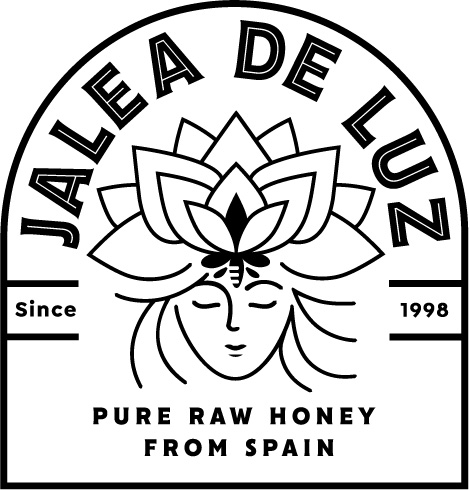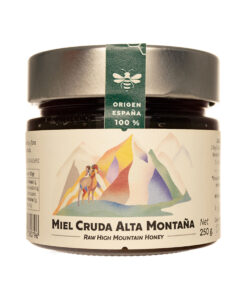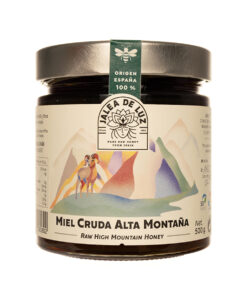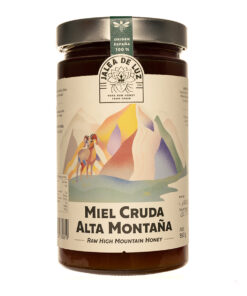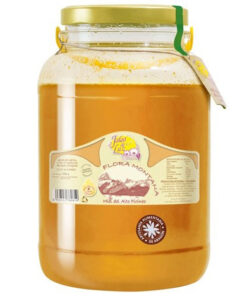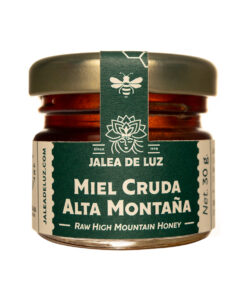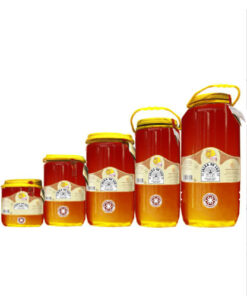High mountain Honey
Origin : Spain and other areas of the Iberian PeninsulaRepresentative specie : Flora pratense and Pyrenean montana.
Main flora composition: Pratenses (Pipirigallo (onobrychis viciifolia), Clover (Trifolium sp),..); Zarza (Rubus ulmifolius L.), Lavender (Lavandula sp), thyme (Thymus vulgaris L.), Hawthorn (Crataegus monogyna L.), oregano (Origanum vulgare L.), Heather ( Erica sp.), Wild fruit trees (Pyrus sp.), Heather (Calluna vulgaris L.), Retama (Lygos sphaerocarpa L.), Rododendro (Rhododendron ferrugineum L.), Oak and Oak (Quercus sp.) and native Pyrenean wild Flora.
Production period: summer.
Color : Amber intense dark color dotted with reddish hues.
Flavor : sweet and intense with slightly acidic notes.
Aroma : penetrating and intense lasting aroma with herbaceous notes.
Peculiarities: raw honey, pure, not homogenized, not filtered, without added sugars.
Conservation : keep dry, semi-dark and cool.
** In its natural process, honey crystallizes and hardens according to various parameters (temperature, floral origin, etc..).
Characteristics of flora MONTANA honey
Although at lower levels of this territory we can still see a high Mediterranean influence (holm oaks, native vegetation of low size such as thyme, lavender,..), most of this natural park is covered by plant communities of a euro-Siberian or boreoalpine nature. At medium altitudes, forests of red pine and extensive Meadows of various legumes are planted, giving way in height to huge forests of Black Pine and spruce, to conclude in high summits with soft natural Meadows and lively rock plants of various shades.Up to 1,500 species covers the Botanical cast of plant species ecosystems in this territory, giving us insight into the variability and richness of native montana flora honey.
Due to extreme weather, native montana flora honey is mostly collected during the short summer, which takes advantage of its light vivaracha, originating a traditional product of dark amber intense color, dotted with reddish hues. Its taste is sweet and powerful with slightly acidic notes sometimes (when the Bush abounds) , saltier in others (if myelates, Heather or other acidophilic species prevail) or neutrals (if they reach the thyme early). It also has a penetrating intense floral aroma very durable, with herbaceous traces characteristic of the predominance legume, mitigated and sweetened by more delicate species of blooms attractive to the tireless pecoreador bees, who leave their hive to carry out endless and fruitful trips.
It has a wide range of minerals (iron, potassium, calcium, phosphorus and magnesium), being also rich in antioxidants, minerals and vitamin C.
Excellencies of High Mountain honey
Like our entire range of honeys and Hive derivatives (pollen, propolis, royal jelly,..), the natural honey of flora montana is collected by our bees in natural places of high environmental purity, fulfilling all the conditions to be a natural product excelso:• Raw: has not been subjected to overheating processes (more than 40 degrees) or pasteurization. It preserves intact all its vitamins, nutrients and enzymes, as well as its extraordinary organoleptic qualities.
• Non-homogenized: to maintain its essence and purity, we never mix natural honeydew from different geographical or floral sources. In this way, the final consumer can fully enjoy all its organoleptic qualities.
• Unfiltered: it is never filtered, because in this way we retain all the natural qualities of the flora of origin, thus achieving an excellent natural elixir unparalleled
• No added sugars: contains natural sugars typical of unadulterated natural honey. Our honey is 100% natural, just as the bee produces it in the hive.
• Pure: the harvest our bees by the hives of pollen and nectar of the flowers, and secretions of plants and sucking insects, to proceed after to its transformation and storage in the cells of the interior of the hive; in this process never involved foreign elements that nature provides.
Usage tips
The natural honey of flora montana collected by our bees have unique characteristics, so if we want to take advantage of all the qualities that can bring us, it is advisable to take them directly, tasting them inside the mouth as long as possible before ingesting them. To make them more manageable in those cases that are preferred diluted, it is recommended at most, warm the "bain-marie" to temperature that never exceeds 40 º to avoid the loss of attributes.Conservation tips
Keep in a dry, semi-dark and cool place to keep intact in a natural way all its qualities.High Mountain Honey, where does it come from?
High mountain honey is produced by bees, as a result of libation to extract pollen and nectar in the flowers of native forest plant species (Bush (Rubus ulmifolius L.), Lavender (Lavandula sp), thyme (Thymus vulgaris L.), Hawthorn (Crataegus monogyna L.), oregano (Origanum vulgare L.), Heather (Erica sp.), Wild fruit trees (Pyrus sp.), Heather (Calluna vulgaris L.), Retama (Lygos sphaerocarpa L.), Rododendro (Rhododendron ferrugineum L.),..), pratense flora varied native wild (Pipirigallo (Onobrychis viciifolia), Clover (Trifolium sp), ..) and resinous substances from shrubby or tree species (Oak and Oak (Quercus sp.),..).In the pecoring process, the bees denote special predilection for the small meadow flowers and traditional forage, being the Clover, Tiny perennial plant of erect stems, trifoliate leaves and pink-purplish flowers with varying shades, one of the most outstanding and mostly collected. It is also worth mentioning the pipirigallo, medium-sized perennial species, with numerous erect stems, very powerful pivoting root, oblong Composite leaves, flowers grouped in Terminal clusters of pink-reddish color and fruit in the form of small legume. Other legumes like Lotus and Vicia complement the wild floral composition with their magnificent blooms.
High Mountain Honey, etymology and History
The pipirigallo or pot comes from Southeast Europe and West Asia, extending and adapting later to more temperate areas Eurasian dry climates and limestone soils; at the end of the sixteenth century began to grow in northern France, in the regions adjacent to the Rhine Valley.Its generic name is Onobrychis, it comes from the Greek: "Onos", = donkey and "βρύκω" (brýko) (eating with eagerness, referring to the ability of the pot to attract donkeys). As for clover or Trifolium, it is a generic name derived from Latin whose meaning is "with three leaves", being also native to Southeast Europe and currently in a situation of extensive colonization of the Iberian Peninsula in vast spontaneous communities.
Recipes with High Mountain Honey
Salmon with honey sauce of flora MONTANA and mustardCook in a small pot a leek, a ripe golden apple, half a sweet onion and a piece of celery, all finely chopped.
In a bowl, add the ingredients previously cooked and mix them with mustard, High Mountain Honey "Jalea de Luz" and a pinch of Brewer's yeast, until a homogeneous dough / sauce. We will cover and store in the refrigerator until final preparation.
Meanwhile, add to salmon sea salt, pepper, parsley and a pinch of paprika and thyme, and cook it in the steam box inside the microwave just long enough for its tuning. Finally, we serve it on a rectangular glass tray on a bed of finely cut lemon, on which we place the cooked salmon and on top, the sauce evenly distributed; we add a crushed rich natural walnuts and ready!!!!
A recipe with a very nutritious traditional flavor.
